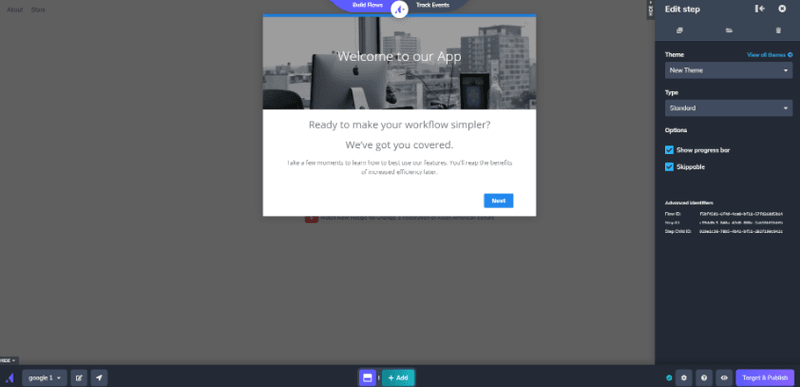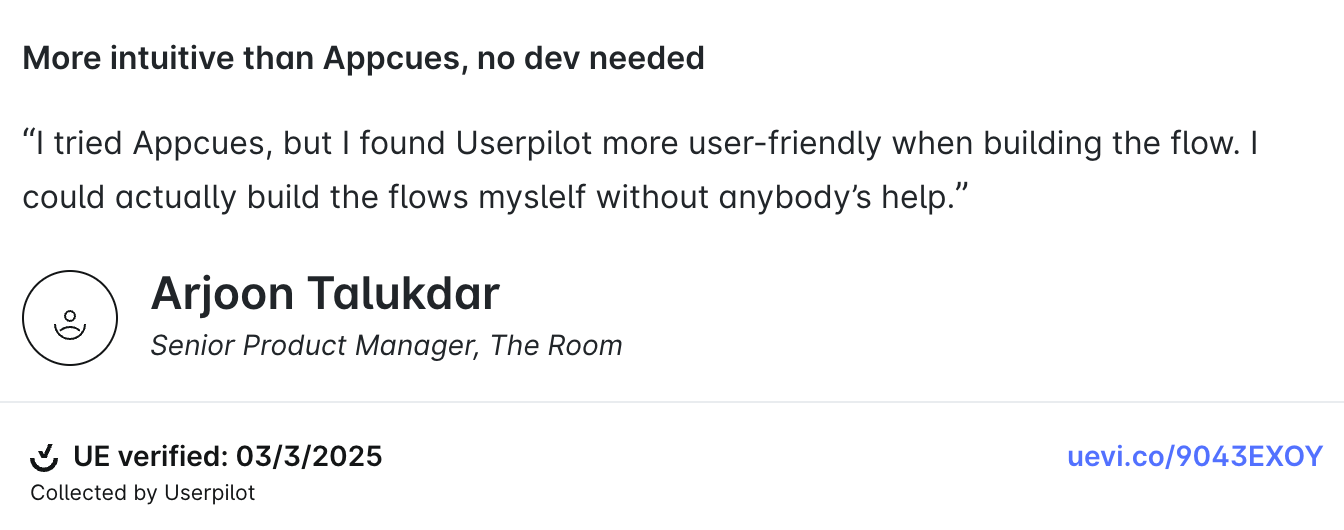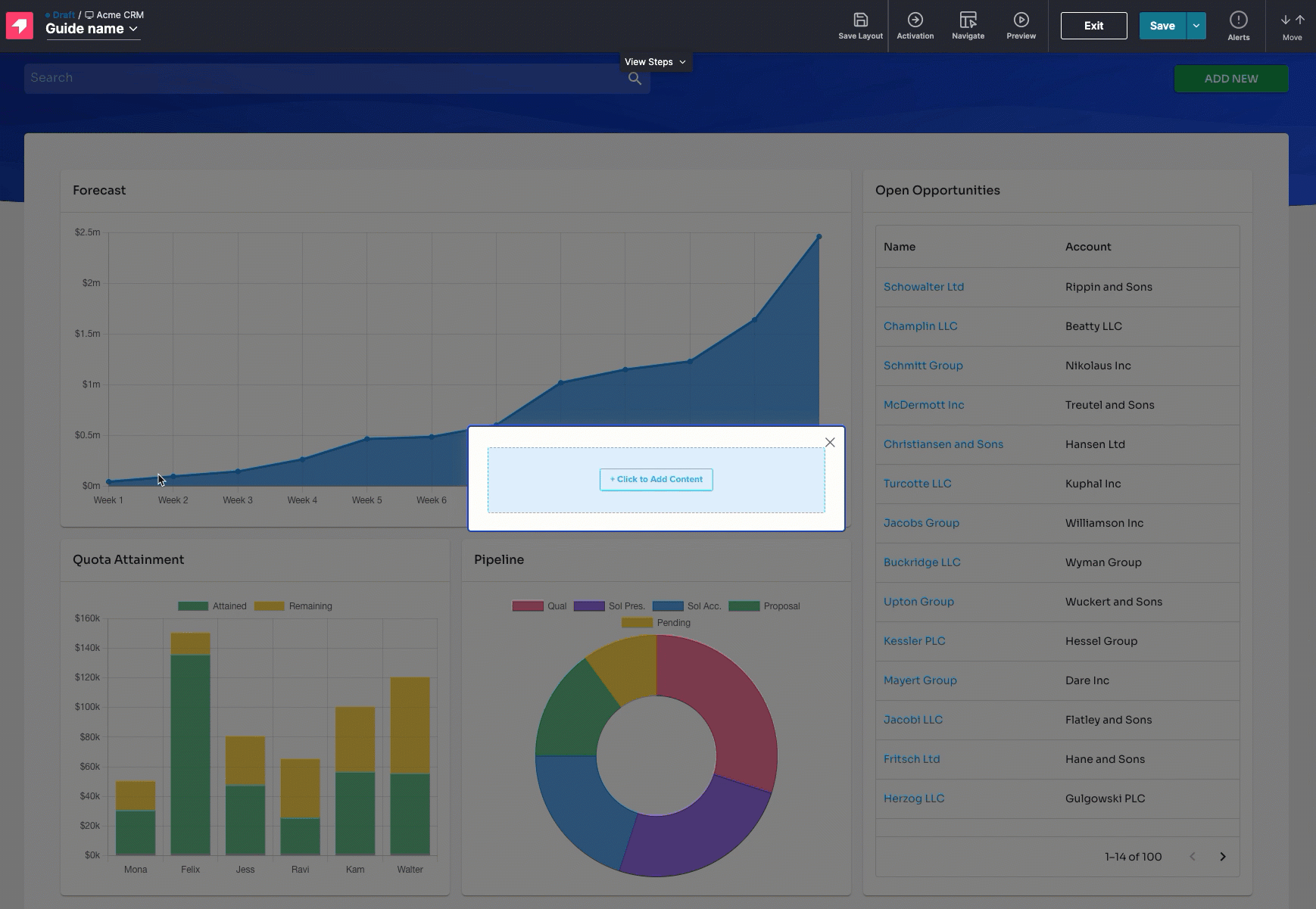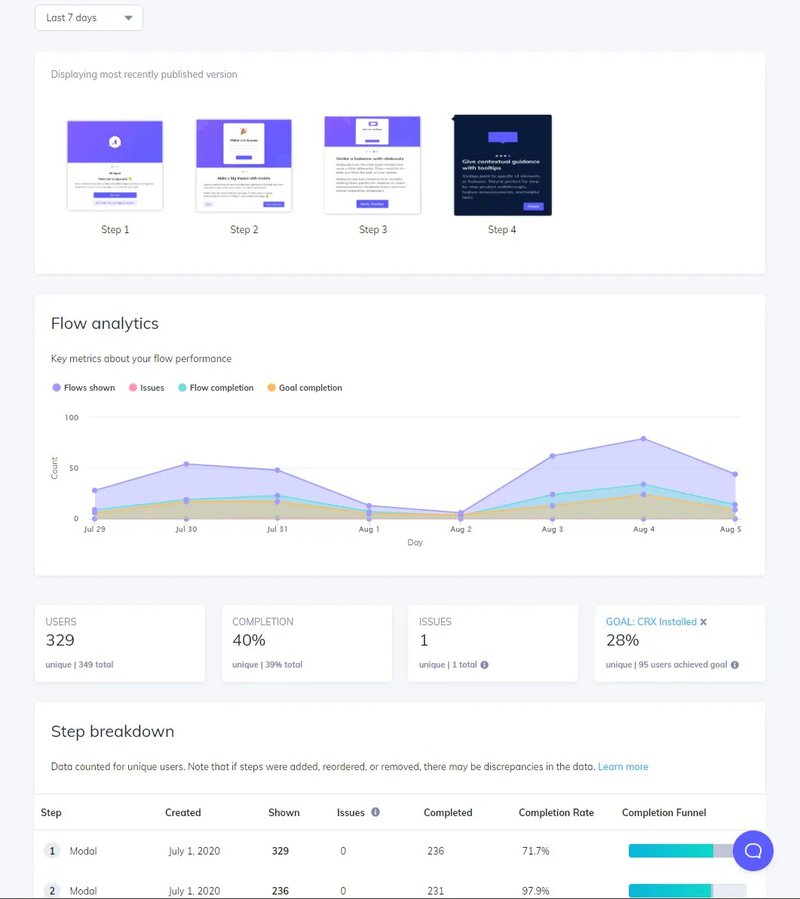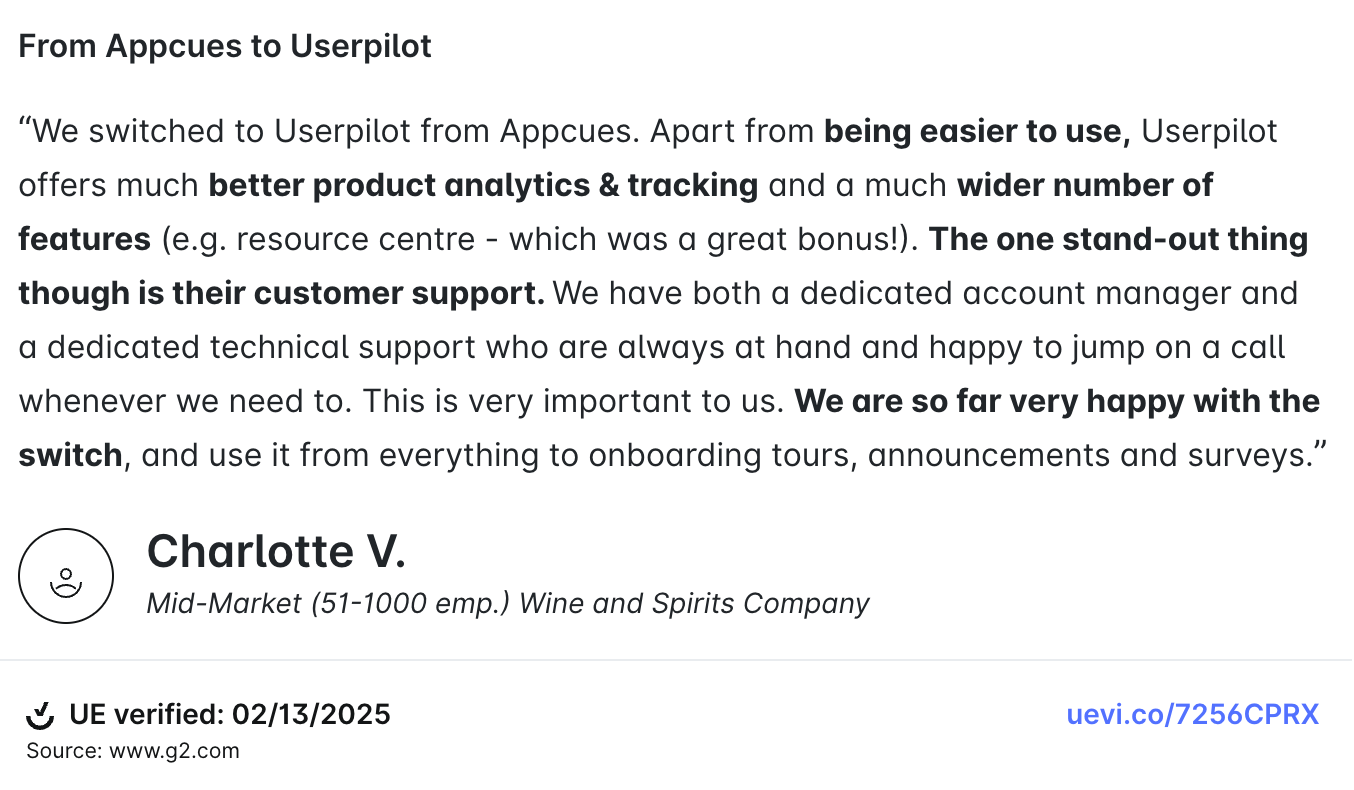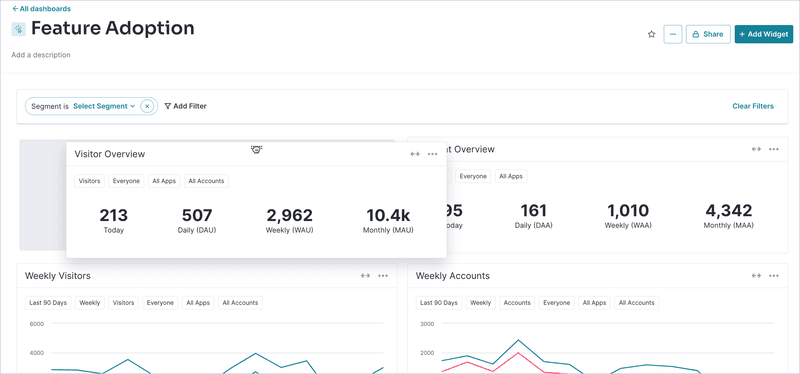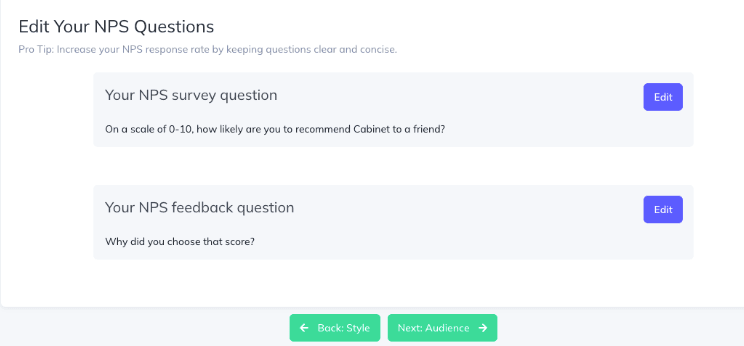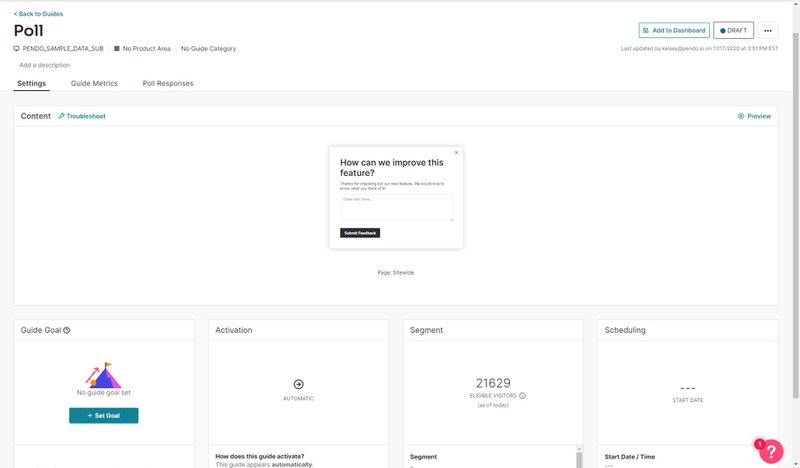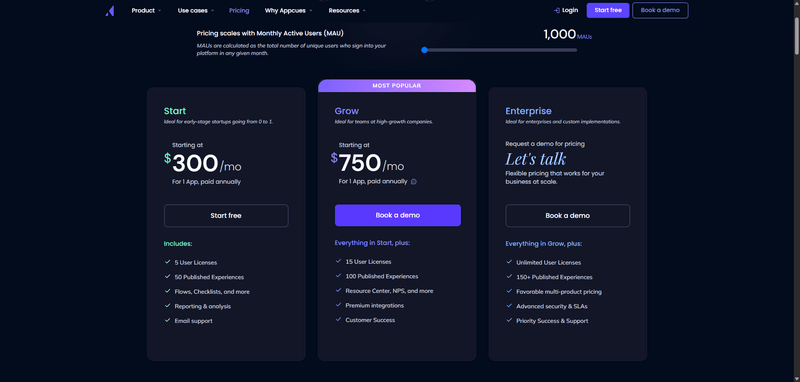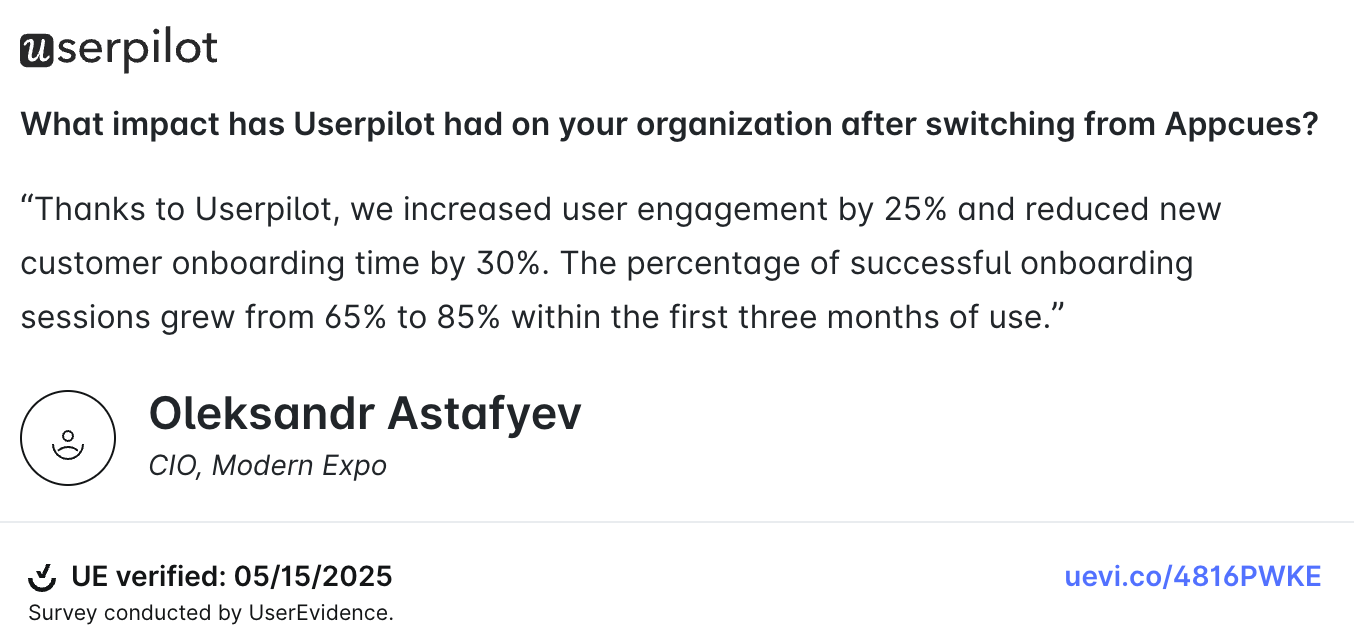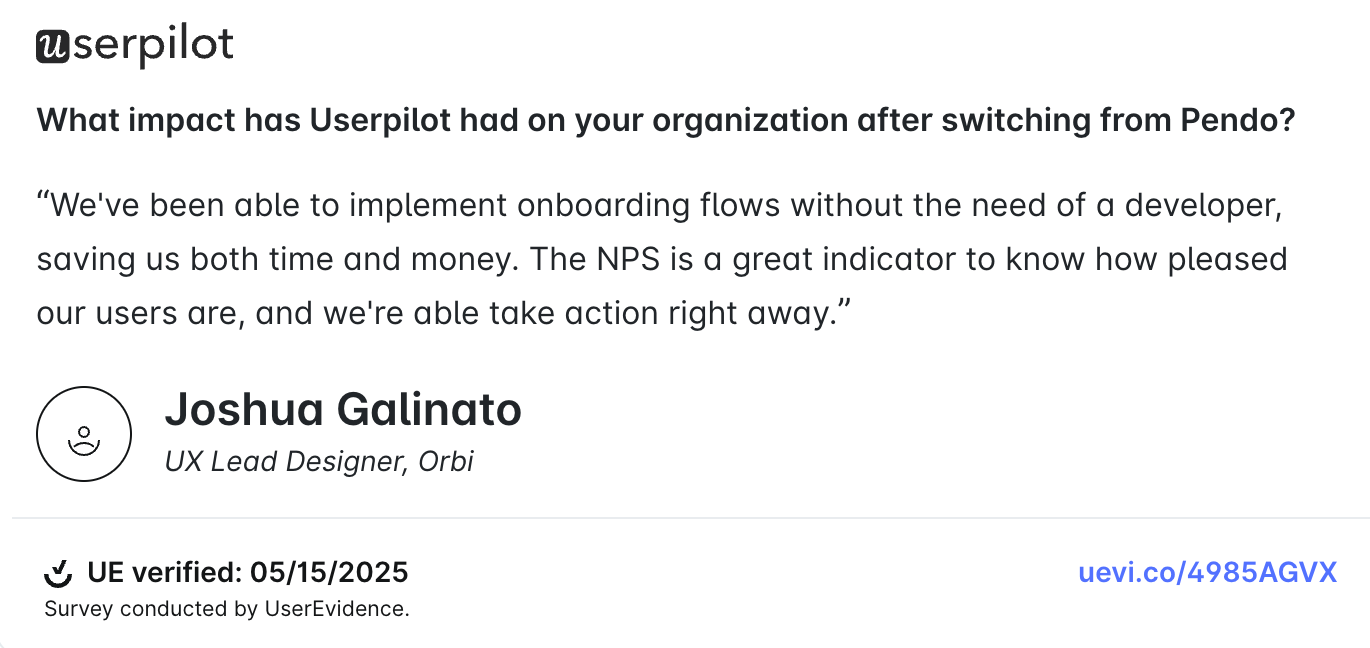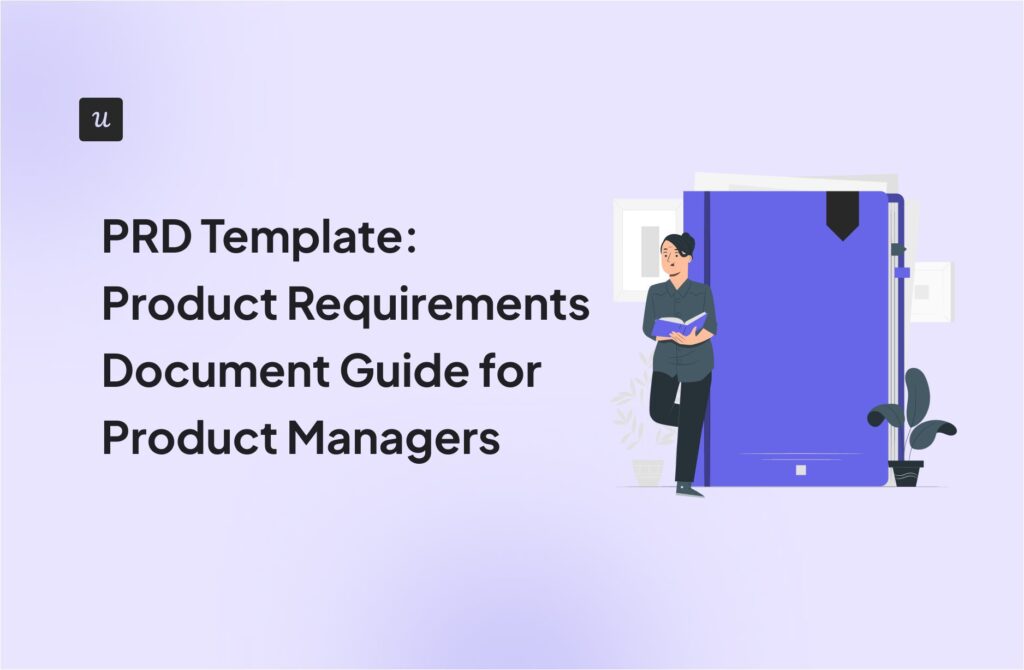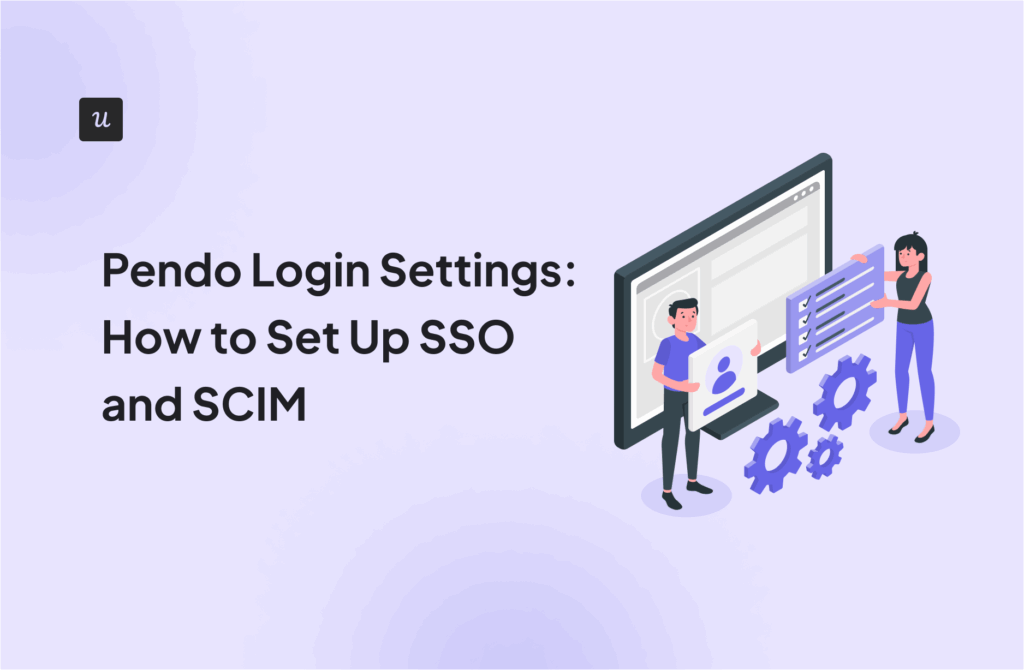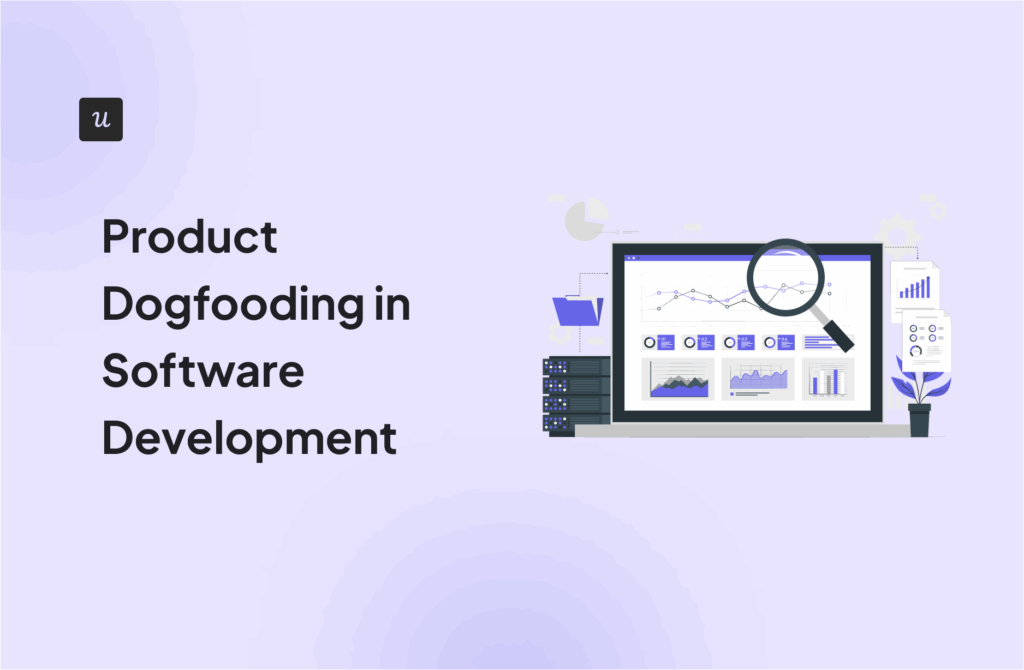
If you’re researching digital adoption platforms, you’ve probably come across Appcues and Pendo. Both were among the first product adoption platforms to hit the market, offering features that marketing, product, and customer success team rely on, especially in SaaS companies aiming for product-led growth.
Appcues is generally favored for its ease of use and strong in-app communication features, while Pendo is known for its robust analytics tools and broader platform for product management.
But if you had to pick, would it be Appcues or Pendo? In this article, we’ll break down the differences, strengths, and alternatives in product onboarding so you can choose the tool that’s right for your goals.
Try Userpilot Now
See Why 1,000+ Teams Choose Userpilot
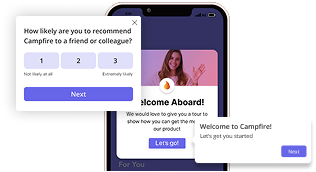
Appcues vs. Pendo: At a glance
In terms of features, Appcues and Pendo have similar offerings. For instance, both user onboarding software solutions offer a WYSIWYG editor to design beautiful in-app onboarding flows, guides, and checklists. You can use various UI patterns to engage and handhold users. It’s also possible to monitor how users engage with different in-app experiences.
However, it’s worth noting that each platform has its unique strengths. If you’re looking for a user onboarding tool that is a no-code platform with extensive user engagement features, Appcues is an excellent fit. On the other hand, Pendo might be the right platform if you want in-depth insights into in-app user behavior and product usage.
| Feature | Appcues | Pendo |
|---|---|---|
| Engagement | In-app experiences (Modals, Tooltips, Checklists, Slideouts), mobile push notifications, email messaging (add-on), Launchpads for self-serve guidance. | In-app guides, tooltips, product tours (web + mobile). Advanced journey orchestration and in-app messaging in higher tiers. |
| Analytics | Basic product usage analytics, event-triggered flows, and Google Analytics integration. | Robust product analytics, retroactive data tracking, session replays, user journeys, AI-powered insights, and Product Engagement Score dashboard. |
| Feedback | In-app NPS and feedback surveys, open-text responses, workflows via Slack, HubSpot, Airtable, and Zapier. | NPS, CSAT, custom surveys (Pulse and above), sentiment analysis. Free plan includes branded NPS.They have a Listen add-on. |
| Integrations | Native integrations: Segment, HubSpot, Salesforce, Clearbrain, Google Analytics. Workflow integrations via Zapier (Slack, Airtable, Sheets, Customer.io). | Limited public details. Data synchronization and advanced integrations are included in the Ultimate tier. Most integrations require higher-tier plans and involve sales personnel. |
| Pricing |
|
Free: Up to 500 MAUs (Pendo-branded).Paid Plans (Base, Core, Pulse, Ultimate): Quote-based, no public pricing. Vendr data suggests that paid plans range from $15,900 to $140,000+ annually. |
Appcues vs. Pendo: User engagement features
User engagement features are a must-have for any product adoption platform. Appcues and Pendo come with extensive capabilities to onboard, educate, and provide in app guidance to users. Let’s take a closer look at each.
| Feature | Appcues | Pendo |
|---|---|---|
| UI patterns | Modals, slideouts, tooltips, hotspots. Advanced styling requires CSS. | Banners, lightboxes, tooltips. Pre-built templates; advanced customization via CSS/JS (higher tiers). |
| Resource center | Launchpads (Growth+): dropdown with access to flows. No search, no categorization, no native FAQs/articles/videos. | Full Resource Center: modules for Guides, Onboarding (checklists), Announcements, and Feedback. Supports segmentation. Search only within Guide List; external KBs embedded via iframe. |
| Checklists | Standalone user onboarding checklists available outside Launchpads. | Checklists only available inside the Resource Center (Onboarding module). No standalone checklists. |
| Event-based triggering | Real-time triggering based on user actions. Enterprise only; add-on for Growth. | Real-time triggers supported. Available in paid tiers (Base+). |
| Segmentation & targeting | Target flows by role, plan, or behavior. Unlimited segments in Growth+; capped in Essentials. | Advanced segmentation by behavior, metadata, or cohorts. Stronger retroactive analytics integration. |
| Frequency & scheduling | Frequency caps and scheduling controls for when flows display. | Frequency caps and scheduling are supported. Enhanced orchestration in higher tiers. |
| Orchestration | Not available. | Journey orchestration for multi-step engagements (Ultimate plan). |
Appcues features for user engagement
As already mentioned, Appcues shines when it comes to in-app engagement functionalities.
First, you get a wide selection of UI patterns like hotspots, modals, slideouts, and tooltips to design user onboarding experiences. You can either use them as standalone in-app messages to announce new features and provide contextual guidance or combine them into product tours.
Appcues provides decent no-code customization options for these UI patterns. However, you’ll have to use CSS for advanced customization.
You can leverage Appcues’s event triggering and automatically launch specific in-app flows based on a user’s real-time actions.
Creating modals in Appcues.
Finally, Appcues has a self-service support feature called “Launchpads” that can be used to provide users with one-click access to all Appcues flows they’ve already interacted with. In other words, they serve as an in-app help center that users can turn to when they get stuck.
However, unlike traditional help centers, launchpads lack categorization and search functionalities. Also, you can’t add other resources, such as articles, FAQs, and video tutorials.
Pendo features for user engagement
You can use the Visual Design Studio to design and customize in-app guides such as banners, light boxes, and tooltips.
If you’re not looking to design in-app flows from scratch, Pendo also offers customizable pre-built templates. Advanced customization is available as an add-on on most plans.
Creating modals in Pendo.
Pendo lets your support team build an in-app help center to organize all knowledge base articles, in-app tutorials, checklists, and other support resources. You can even include a feedback widget and a roadmap to collect feedback from users. Plus, it allows you to tailor the resource center’s content for different user segments.
Checklists are available as a part of Pendo’s resource center and guide users to activation events. They’re particularly useful for giving new users a clear idea of the steps they should take to start accomplishing their goals with your product. Additionally, with Guides Pro, you can create Tasks in Guides to provide users with actionable steps during their onboarding or engagement process.
Pendo doesn’t offer the option to create standalone checklists outside of guides or resource center, though.
“With Pendo, I could not do, or at least I didn’t know how to easily do, specific flows for specific companies. With Userpilot, I can do it very easily without needing developer assistance.”
Leyre Iniguez, Customer Experience Lead at Cuvama
Appcues vs. Pendo: Product analytics features
Product analytics features are an integral part of any digital adoption platform and offer an in-depth understanding of in-app activity and product usage data. Plus, they let you stay on top of users’ changing needs and pain points.
Here’s what Appcues and Pendo offer:
| Feature | Appcues | Pendo |
|---|---|---|
| Event Tracking & Analytics | No-code event tracking; Events Explorer with visual dashboards | Automated event capture; retroactive analytics with minimal setup |
| Flow & Guide Analytics | Flow performance, variation testing, goals, funnel insights | Path & funnel analysis; feature adoption tracking |
| Feedback & Behavioral Analysis | NPS, checklist, Launchpad, banner & push analytics | Feature usage insights; account & user-level behavior data |
| Targeting & Segmentation Insights | Segmentation is supported in analytics dashboards | Segment comparisons across reports and features |
| Integrations & Data Export | Exports (CSV), integrations with Mixpanel/Heap/Amplitude | Custom exploration via Data Explorer; multi-app data visibility |
| Experimentation Tools | A/B testing and control experiments | Pendo provides tools for running A/B tests, also known as experiments, to optimize in-app guides and other features. |
| AI & Insights Automation | Manual analytics, visualization, and goals | AI-powered recommendations and insights |
Appcues for product analytics
Appcues has a very basic analytics suite; it only provides analytics related to flows, checklists, and other content created with it.
Here are some features for analyzing the performance of your Appcues-authored content:
- User segmentation: You can choose from four pre-defined user segments, Explorers, Beginners, Regulars, and Champions, or create groups from scratch. Appcues lets you divide users into different groups based on in-app activity, online behavior, persona, and lifecycle stage.
- Flow analytics: You can track the performance of Appcues flows, including total views and completion rates.
- Goal tracking: With Appcues, you can set up and monitor specific goals to evaluate the effectiveness of your in-app flows. For instance, it’s possible to set goals related to activation events to understand how good your Appcues flows are at driving user activation.
- Checklist analytics: You can track how many users viewed, completed, and skipped Appcues checklists. It can help you optimize the timing and content of checklists to improve engagement.
- Event tracking: If you want to track user actions outside Appcues flows, you’ll have to set up custom events. It requires coding knowledge and can be challenging for non-technical users.
Pendo for product analytics
Pendo’s product analytics tools offer product teams detailed insights into user behavior and needs.
Key features include:
- Session replay: You can visualize and playback user sessions to get a full breakdown of how users interact with your product. This feature is available on most plans except the free plan (it’s only included in the Base plan as an add-on, though.)
- Autocapture: Besides tracking custom events, Pendo also comes with automatic feature tagging. It ensures that you capture and analyze every user action, even if you don’t create custom events for certain features.
- Custom dashboards: You can customize the dashboard widget to keep an eye on the metrics and reports that matter the most.
- Funnel charts: You can create multi-step funnels to understand how users move from one stage to the next in their journeys. Pendo’s funnel charts let you analyze conversion rates at each step and identify drop-off points.
- Cohort analysis: Pendo’s cohort analysis report offers a closer look into user retention and churn.
- Paths: You can use Pendo’s no-code path builder to visualize and assess user paths and identify areas of friction.
Appcues vs. Pendo: Customer feedback features
Collecting user feedback is the key to identifying gaps in the user experience and improving your product.
Let’s find out what Appcues and Pendo offer in this regard:
| Feature | Appcues | Pendo |
|---|---|---|
| In-App Surveys | Modal/slideout forms: NPS, single/multi-select, free-text inputs. | Polls embedded via Guides (modal, banner) support NPS, CSAT, etc. |
| Feedback Capture | Primarily, NPS and survey responses. | Feature requests via the Pendo Listen; surveys via Guides. |
| Analysis & Prioritization | NPS analytics, exportable for manual analysis. | AI insights, trend filtering, feedback widgets, and segment-specific views. |
| Integration | NPS targeting, translation, and styling control. | Integrates with external CRMs and feedback tools; in-platform segmentation. |
| Voice of Customer Support | Flexible survey deployment, targeting, lacks deep prioritization tools. | Built-in tool for grouping, prioritizing, and acting on feedback. |
Appcues features for user feedback
The user feedback capabilities are limited to Net Promoter Score (NPS) surveys. You can customize pre-built NPS survey templates and segment users based on their responses. Then, you can launch personalized in-app experiences for each segment.
NPS survey in Appcues.
For instance, you can encourage Promoters to review your app and ask Detractors to share qualitative feedback.
Keep in mind that Appcues doesn’t have a standalone module for surveys. Instead, all surveys and forms are embedded into modals with some customization.
Pendo features for user feedback
Pendo’s user feedback features are more extensive than those of Appcues. For starters, you can conduct NPS surveys both in-app and via email. You can also use in-app prompts to collect qualitative feedback and even conduct polls.
Plus, Pendo integrates with tools like Salesforce and Zendesk and lets you consolidate feedback collected across different platforms. You even have the option to test different product ideas and ask users about their experience.
Creating polls in Pendo.
The best part is that Pendo uses AI algorithms to extract actionable insights from survey data. You can also choose to create custom feedback views where you only see responses from specific user segments or product areas.
Feature idea validation at scale is also feasible with Pendo Validate. With it, you can create idea tests, display them to customer segments, and collect quantitative user feedback to understand if they strike a chord with them.
Pendo vs. Appcues: Integrations
Third-party integrations enhance a product growth platform’s capabilities. Here’s what Appcues and Pendo offer in this context:
| Integration Category | Appcues | Pendo |
|---|---|---|
| Analytics | Google Analytics, Amplitude, Mixpanel, Heap, Kissmetrics | Data exports via Data Sync; Fivetran for warehousing |
| CRMs & Feedback Tools | Salesforce, HubSpot, Marketo, Zendesk | Salesforce, HubSpot, Zendesk, Intercom, Jira |
| Engagement / Messaging | Intercom, Customer.io, Slack, Klaviyo, Localytics | Embed Intercom chat; Guide integrations with Figma, Qualtrics, etc. |
| Data Pipeline & Sync | Segment, RudderStack, Zapier, Hightouch | Data Sync (GCS, AWS, Azure), APIs, Tray.io, Zapier |
| Developer Tools | Robust support via Segment, Zapier, and integrations doc | API/Webhooks, Tray.io, custom integration via developer ecosystem |
| Scope & Direction | Mix of one-way and two-way depth across tools | Broad, enterprise-grade with deep bidirectional syncs and orchestration |
Pendo integrations
Pendo offers a massive, “app store”-style catalog of 70+ native integrations across CRM (Salesforce, HubSpot), support (Zendesk, Freshdesk), data platforms (Segment, Google Cloud Storage, Amazon S3, Snowflake, Redshift), collaboration (Slack, Confluence), analytics/BI (Looker, Tableau, Domo), developer tools (Figma, InVision), and even guide-specific embeds (Qualtrics, Calendly, UserTesting).
Pendo’s plans get exactly one built-in integration included; any others must be purchased as add-ons.
To enable additional connectors (e.g. Salesforce beyond your first, or Segment), you must buy each as a paid add-on—Pendo requires you to contact your account rep for pricing.
Appcues integrations
Appcues offers an impressive suite of third-party integrations through APIs and webhooks. From Mixpanel, Amplitude, and Google Analytics to Jira, Marketo, and Salesforce, you can connect Appcues with almost any tool in your tech stack.
You can overcome many of Appcues’ limitations, such as a lack of in-depth analytics, with these integrations. However, it doesn’t always provide two-way data syncing. While it offers a wide spectrum of integrations, Pendo’s integrations may provide more flexibility for certain use cases.
Pendo vs. Appcues: Pricing
Here’s a clear pricing comparison table for Appcues vs. Pendo:
| Plan / Tool | Appcues | Pendo |
|---|---|---|
| Free | ❌ No free plan (14-day trial only). | ✅ Free forever, up to 500 MAUs. Includes retroactive analytics, roadmaps, in-app guides, branded NPS. |
| Entry (Base/Essentials) | Essentials: ~$249–$300/mo (1K–2.5K MAUs). Basic flows, limited segments/events, email support. | Base: Core analytics, dashboards, in-app guides, 1 integration. ❌ No NPS, ❌ No replays. (Custom pricing). |
| Mid (Growth/Core) | Growth: ~$750–$879/mo (1K–2.5K MAUs). Adds checklists, Launchpads, NPS, premium integrations, unlimited segments. | Core: Everything in Base + session replays. (Custom pricing). |
| Advanced (Pulse) | ❌ Not applicable (Appcues jumps to Enterprise). | Pulse: Core + white-labeled NPS, product discovery (feedback portal, idea validation). |
| Enterprise/Ultimate | Enterprise: Custom pricing. Unlimited scale, advanced security, priority support. | Ultimate: Pulse + Pro in-app guides, journey orchestration, data synchronization. Custom pricing (reports range $15K–$140K+/yr). |
Pendo pricing
Pendo’s pricing is expensive and non-transparent; costs escalate quickly with opaque MAU-based pricing, undisclosed add-on fees, and renewal uplifts of 5–10% (sometimes up to 20%), making total spend unpredictable and often far higher than initial quotes. Companies are typically required to commit to multi-year contracts to secure pricing caps.
Pendo’s pricing information isn’t listed on the website. You’ll have to contact the sales team for a quote.
Appcues pricing
Appcues offers three paid plans, and the total cost depends on MAUs. Pricing tiers include:
- Essentials: Starting at $300 per month (billed annually) for 1,000 MAUs. This plan includes 5 licenses, core UI patterns (modals, slideouts, tooltips, hotspots, checklists), up to 50 published experiences, and basic analytics. It does not include the Resource Center, Launchpads, or NPS surveys.
- Growth: Starting at $750 per month (billed annually) for 1,000 MAUs. This plan includes 15 licenses, up to 100 published experiences, advanced features like checklists, Launchpads, Resource Center, NPS surveys, and custom CSS, plus premium integrations (e.g., Salesforce, HubSpot, Zendesk, Slack, Segment).
- Enterprise: Custom pricing based on scale. This plan adds unlimited licenses, 150+ published experiences, advanced security and governance (SSO, roles/permissions, localization, SLAs), and priority support.
Appcues offers a 14-day free trial for all paid plans (no credit card required). It’s important to note that with a starting price of $300 per month, Appcues is on the higher end of product adoption tools, and MAU-based pricing means costs can rise quickly as your user base grows.
Appcues pricing details.
Userpilot: A better alternative to Appcues and Pendo
While Appcues and Pendo offer impressive user engagement and analytics features, it’s difficult to label them as “all-in-one.” If you’re looking for a solution that covers all your product adoption needs, Userpilot deserves a shot.
Notable features of Userpilot include:
- Autocapture: Userpilot automatically tracks and captures user actions like clicks, form submissions, and text input changes, meaning you don’t have to manually create custom events.
- Custom dashboards: With Userpilot, you can set up custom analytics dashboards with the reports and KPIs that matter to you. You can even filter the data for specific date ranges, user profiles, and more.
- Analytics reports: Userpilot offers a broad spectrum of analytics reports to help you take a deep dive into user behavior. While funnel analysis lets you identify drop-off points, path analysis helps you identify happy paths for different user personas. You can also uncover patterns in user behavior with trend analysis, analyze churn with cohort analysis, measure retention, and track time-to-value to see how quickly users activate.
- In-app surveys: You get 14+ pre-built survey templates, including NPS, CSAT, CES, feature feedback, and churn surveys. These enable you to collect both quantitative and qualitative feedback and trigger surveys contextually based on user behavior.
- Robust resource center: Userpilot lets you build an in-app resource center where you can add links to support docs, FAQs, videos, and product news. Plus, there’s a search bar to help users easily navigate the help center—something both Pendo and Appcues don’t have.
- User profiles: You can create detailed user profiles, including names, job titles, sign-up dates, total number of sessions, and more. Userpilot also provides insights into each user’s activity, including performed events, visited pages, and survey responses.
- In-app engagement layer: Build tooltips, modals, slideouts, hotspots, banners, and checklists without code. These can be personalized by segment or triggered based on behavior, helping you design tailored user onboarding and adoption flows.
- Email: Send behavior-triggered emails directly from Userpilot, ensuring users receive relevant communication even when they’re outside your product. Email campaigns can be combined with in-app experiences for multi-channel engagement.
- Session recording & replay: Watch replays of how users interact with your product to identify friction points and see the full context behind user behavior.
- Mobile support: Create user onboarding flows, carousels, and push notifications for iOS and Android apps. Track events, screen views, funnels, and paths across mobile products.
- Advanced segmentation: Target flows, surveys, and emails by user role, subscription plan, lifecycle stage, behavioral events, or custom attributes. Unlike Appcues’ Essentials plan, segmentation is unlimited in Userpilot.
- Professional services (optional): Enterprise teams can access hands-on migration, implementation, and strategic support from Userpilot’s team.
Why choose Userpilot over Appcues?
Userpilot’s native analytics and user feedback features are more extensive.
Plus, you can build a full-fledged in-app resource center to enable self-service support. Userpilot’s Growth plan offers better value for money than the equivalent plan on Appcues.
| Category | Userpilot | Appcues |
|---|---|---|
| Analytics 📊 | ✅ Advanced: funnels, paths, trends, cohorts, retention, time-to-value. Custom dashboards & filters. | ⚠️ Basic flow/event analytics. For depth, must integrate with Amplitude, Mixpanel, etc. |
| Event tracking 🔍 | ✅ Autocapture: clicks, form fills, text inputs tracked automatically. | ❌ Manual event tagging required. No full autocapture. |
| In-app surveys 📝 | ✅ 14+ templates (NPS, CSAT, CES, churn, feature feedback). Branching logic + targeting. | ⚠️ NPS + simple forms only. Limited survey options. |
| Resource center 📚 | ✅ Full hub: add docs, FAQs, videos, product news. Includes search bar + categories. | ❌ Launchpad only: shows past flows. No search, no external resources. |
| In-app engagement 🎯 | ✅ Tooltips, modals, slideouts, hotspots, banners, checklists. Behavior-triggered. | ✅ Tooltips, modals, slideouts, hotspots, checklists. Fewer targeting options. |
| Session replay 🎥 | ✅ Available: watch recordings of real user sessions. | ❌ Not available. |
| Segmentation 🎯 | ✅ Unlimited: target by attributes, events, behavior, lifecycle stage. | ⚠️ Limited in Essentials; unlimited only in higher plans. |
| Mobile 📱 | ✅ iOS/Android onboarding, carousels, push notifications, mobile analytics. | ⚠️ Mobile flows supported, but fewer advanced options. |
| Email ✉️ | ✅ Built-in behavior-triggered emails for multi-channel engagement. | ✅ Pendo Orchestrate combines in-app and email communication. |
| Customization 🎨 | ✅ Advanced styling + no-code builder. CSS optional. | ✅ Very good advanced styling |
| Pricing 💵 | ✅ More features included out-of-the-box; better value as you scale. | ⚠️ Starts at $300/mo (1,000 MAUs); costs rise quickly with growth. |
Why choose Userpilot over Pendo
In contrast to Pendo, Userpilot is easier to use, can create standalone onboarding checklists, and supports standalone surveys with a greater variety of templates.
Plus, all third-party integrations are included in the overall pricing, which isn’t the case on Pendo.
| Category | Userpilot | Pendo |
|---|---|---|
| Pricing 💵 | Starts lower; more features are included by default. | ❌ Opaque pricing (must contact sales). Contracts often $15K–$100K+/year. |
| Analytics 📊 | ✅ Funnels, paths, cohorts, retention, time-to-value, trends — all built-in. | ✅ Advanced analytics: retroactive tracking, Product Engagement Score, AI insights. |
| Event tracking 🔍 | ✅ Autocapture: clicks, inputs, form submissions tracked automatically. | ⚠️ Screen and feature views (not scroll depth/input fields/rage clicks/time on screen, unless approximate), interactions with non-visual/dynamic elements |
| In-app surveys 📝 | ✅ 14+ survey templates (NPS, CSAT, CES, churn, feature feedback). Branching logic. | ⚠️ NPS, CSAT, polls available but more limited. Some features locked to higher plans. |
| Resource center 📚 | ✅ Full in-app hub: articles, FAQs, videos, announcements, surveys. With search bar. | ✅ Resource Center with modules (guides, onboarding, feedback, announcements). ❌ No global search (only in Guide List). |
| In-app engagement 🎯 | ✅ Tooltips, modals, slideouts, hotspots, banners, checklists. Behavior-triggered flows. | ✅ Tooltips, banners, lightboxes, walkthroughs. Orchestration in Ultimate plan. |
| Session replay 🎥 | ✅ Native session replays included. | ⚠️ Session replays only available in Core+ plans. |
| Segmentation 🎯 | ✅ Unlimited targeting by attributes, behavior, lifecycle stage, and events. | ✅ Advanced segmentation (account- and user-level), tied deeply to analytics. |
| Mobile 📱 | ✅ iOS/Android onboarding flows, carousels, push notifications, mobile analytics. | ✅ Mobile in-app guides + analytics supported. |
| Email ✉️ | ✅ Built-in behavior-triggered emails for multi-channel engagement. | ✅ They have an email option with Pendo Orchestrate add-on. |
| Customization 🎨 | ✅ Strong no-code editor + optional CSS. | ⚠️ More technical setup required for advanced styling/customization. |
| Ease of use ⚡ | ✅ Designed for product teams, no engineering dependency. | ⚠️ Steeper learning curve; often requires admin/IT resources. |
Appcues, Pendo, or a better alternative?
Appcues features an intuitive drag-and-drop editor and multiple UI patterns but lacks native analytics. Pendo’s analytics features are more robust, offering in-depth insights like session replays and funnel analysis. However, its behavior-based triggering, while available, isn’t as intuitive or user-friendly as some other platforms.
If you’re looking for an easy-to-use product adoption platform that combines good user engagement features with in-depth product analytics, Userpilot is a better fit.
Schedule a Userpilot demo to see the platform in action.
Userpilot strives to provide accurate information to help businesses determine the best solution for their particular needs. Due to the dynamic nature of the industry, the features offered by Userpilot and others often change over time. The statements made in this article are accurate to the best of Userpilot’s knowledge as of its publication/most recent update on August 18, 2025.

